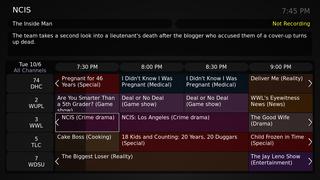
A set-top box (STB), also known as a cable box, receiver, or simply box, and historically television decoder or a converter, is an information appliance device that generally contains a TV tuner input and displays output to a television set, turning the source signal into content in a form that can then be displayed on the television screen or other display device. It is designed to be placed alongside or "on top" of a television set.
Video on demand (VOD) is a media distribution system that allows users to access videos, television shows and films digitally on request. These multimedia are accessed without a traditional video playback device and a typical static broadcasting schedule, which was popular under traditional broadcast programming, instead involving newer modes of content consumption that have risen as Internet and IPTV technologies have become prominent, and culminated in the arrival of VOD and over-the-top (OTT) media services on televisions and personal computers.
Television broadcasts in the United Kingdom began in 1932, however, regular broadcasts would only begin four years later. Television began as a public service which was free of advertising, which followed the first demonstration of a transmitted moving image in 1926. Currently, the United Kingdom has a collection of free-to-air, free-to-view and subscription services over a variety of distribution media, through which there are over 480 channels for consumers as well as on-demand content. There are six main channel owners who are responsible for most material viewed.

TV Guide is an American digital media company that provides television program listings information as well as entertainment and television-related news.

Television is one of the major mass media outlets in the United States. In 2011, 96.7% of households owned television sets; about 114,200,000 American households owned at least one television set each in August 2013. Most households have more than one set. The percentage of households owning at least one television set peaked at 98.4%, in the 1996–1997 season. In 1948, 1 percent of U.S. households owned at least one television; in 1955, 75 percent did. In 1992, 60 percent of all U.S. households had cable television subscriptions. However, this number has fallen to 40% in 2024.

Pop, commonly referred to as Pop TV, is an American pay television channel owned by Paramount Global under its networks division through MTV Entertainment Group. It is a general entertainment channel, focusing primarily on programs pertaining to popular culture.
Pay television, also known as subscription television, premium television or, when referring to an individual service, a premium channel, refers to subscription-based television services, usually provided by multichannel television providers, but also increasingly via digital terrestrial and streaming television. In the United States, subscription television began in the late 1970s and early 1980s in the form of encrypted analog over-the-air broadcast television which could be decrypted with special equipment. The concept rapidly expanded through the multi-channel transition and into the post-network era. Other parts of the world beyond the United States, such as France and Latin America have also offered encrypted analog terrestrial signals available for subscription.

Electronic programming guides (EPGs) and interactive programming guides (IPGs) are menu-based systems that provide users of television, radio, and other media applications with continuously updated menus that display scheduling information for current and upcoming broadcast programming. Some guides also feature backward scrolling to promote their catch up content. They are commonly known as guides or TV guides.
In most telecommunications organizations, a virtual channel is a method of remapping the program number as used in H.222 Program Association Tables and Program Mapping Tables to a channel number that can be entered as digits on a receiver's remote control.
Television encryption, often referred to as scrambling, is encryption used to control access to pay television services, usually cable, satellite, or Internet Protocol television (IPTV) services.

TV listings are a printed or electronic timetable of television programs. Often intended for consumer use, these provide information concerning programming scheduled to be broadcast on various television channels available to the reader – either via terrestrial, free-to-air, cable, satellite or over-the-top MVPD – indicating at what time and on what channel they are due to be broadcast over a period usually encompassing about seven- to 14-days in advance.
In Demand is an American cable television service which provides video on demand services, including pay-per-view. Comcast, Cox Communications, and Charter Communications jointly own In Demand.
Solar Entertainment Corporation is a Filipino media company based in Makati, Philippines. Founded and owned by the brothers, Wilson, William and Willy Tieng. Solar Entertainment operates four digital free-to-air channels and one cable channel. Solar also owns a film distribution company and defunct freemium digital television service.
Cable television first became available in the United States in 1948. By 1989, 53 million U.S. households received cable television subscriptions, with 60 percent of all U.S. households doing so in 1992. Most cable viewers in the U.S. reside in the suburbs and tend to be middle class; cable television is less common in low income, urban, and rural areas.

Sneak Prevue was an American pay television network that served as a barker channel to provide previews of pay-per-view films and events to cable television providers. The channel launched in 1991 and existed until 2002.
A multichannel television service, also known as simply a television provider, is a type of service provider who distributes television programming to its customers for a subscription fee. Subscription television providers distribute television channels that offer different types of programming, typically including local television stations within their market, specialty channels that are distributed solely through multichannel television providers, and pay television services that offer premium content such as feature films and other original programming.
Sportsnet PPV is a Canadian pay-per-view (PPV) service owned by Rogers Communications. It is the PPV service used by Rogers Cable, Cogeco Cable and Source Cable for offering out-of-market sports packages and occasionally other special events. Since October 1, 2014, Rogers and Source have also used Sportsnet PPV as their main general-interest pay-per-view provider, replacing Viewers Choice which shut down the previous evening. The service is co-branded with Rogers' sports channel Sportsnet.

Cignal TV, Inc., also known by its legal trading name Mediascape Inc., is a Filipino media and telecommunications firm in the Philippines. A wholly owned subsidiary of the media company MediaQuest Holdings under the PLDT Beneficial Trust Fund, the firm operates its pay television services, subscription television networks, television and film entertainment production, and fiber broadband internet.
The American cable and satellite television network Pop was originally launched in 1981 as a barker channel service providing a display of localized channel and program listings for cable television providers. Later on, the service, branded Prevue Channel or Prevue Guide and later as Prevue, began to broadcast interstitial segments alongside the on-screen guide, which included entertainment news and promotions for upcoming programs. After Prevue's parent company, United Video Satellite Group, acquired the entertainment magazine TV Guide in 1998, the service was relaunched as TV Guide Channel, which now featured full-length programs dealing with the entertainment industry, including news magazines and reality shows, along with red carpet coverage from major award shows.

WGN America was an American subscription television network that operated from November 9, 1978 to February 28, 2021. The service was originally uplinked to satellite by United Video Inc. as a national feed of Chicago independent station WGN-TV, making the station's programming available to cable and satellite providers throughout the United States as the second nationally distributed "superstation".








